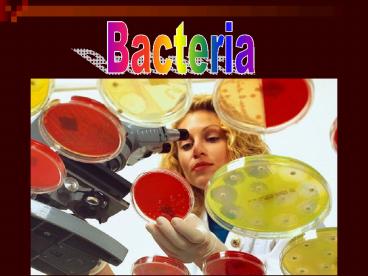Bacteria - PowerPoint PPT Presentation
1 / 28
Title:
Bacteria
Description:
Bacteria consist of only a single cell, but don't let their small size and seeming simplicity fool you. They're an amazingly complex and fascinating group of creatures. – PowerPoint PPT presentation
Number of Views:178
Avg rating:3.0/5.0
Title: Bacteria
1
Bacteria
2
- Bacteria consist of only a single cell, but don't
let their small size and seeming simplicity fool
you. They're an amazingly complex and fascinating
group of creatures.
3
Builders of Modern Life
- Bacteria are among the earliest forms of life
that appeared on Earth billions of years ago. - Bacteria helped shape and change the young
planet's environment, eventually creating
atmospheric oxygen that enabled other, more
complex life forms to develop.
4
What are bacteria?
- Bacteria are unicellular, living things.
- Prokaryotic cells (without a nucleus).
- Obtain nutrients is different ways
- Photosynthetic autotrophs- convert inorganic
molecules into sugar using sunlight - Heterotrophs- consume food by growing on it
- Saprophytes- obtain food by decomposing dead
material - Chemotrophs- manufacture organic compounds from
inorganic compounds such as hydrogen sulfides
5
Bacteria feeding on saguaro
Cyanobacteria in a lake
Bacteria used in wastewater treatment
Chemotrophs at hydrothermal Vent
6
(No Transcript)
7
(No Transcript)
8
Classification of Prokaryotes
- All prokaryotes belong to the kingdoms
- Archaea
- Eubacteria
9
Archaea
- First discovered in 1970s
- Discovery made the term Moneran obsolete
- Biochemically different from eubacteria
- May have evolved in the harsh conditions of early
Earth - They are abundant in, but not restricted to,
extreme environments because of their ability to
withstand the harshest of environments - May be the early ancestors of eubacteria
10
Characteristics of Archaea
- Archaea (Formerly Archaebacteria)
- Lack an important carbohydrate (peptidoglycan)
found in the cell wall of nearly all Eubacteria. - Live in harsh environments
- Oxygen-free environments
- Methanogens (ex. Thick mud digestive tracts)
- Produce methane gas
- Salty environments
- Extreme Halophiles
- Great Salt Lake/Dead Sea
- Hot Springs
- Thermoacidophiles
11
Characteristics of Eubacteria
- Eubacteria Modern Bacteria
- Unicellular
- Cell walls contain peptidoglycan
- Genes lack introns
- Reproduce asexually by binary fission
- Either autotrophic or heterotrophic
- Extremely diversified groups
- Certain types may be ancestors of mitochondria
12
Identifying Prokaryotes
- Bacterial Shapes
- Bacillus Rod
- Coccus Round
- Sprillium Spiral
- Colony growth
- Cells arranged in particular ways
- Form long chains
- Grow in clusters
- Bacterial movement
- Flagella
- Some do not move
- Some glide
13
- Shape 1 is rod shape, also known as bacillus.
14
- Shape 2 is sphere shaped, also known as coccus.
15
- Shape 3 is spiral shape, also known as sprillum
16
Micrococcus luteus tetrad
Bacillus cereus
Vibrio
Rhodospirillum
17
Bacterial Structures
- Cell Wall- support and protection
- No nucleus- Bacterial DNA is usually coil-shaped
and not enclosed in a nuclear membrane. - Most bacteria also have small ring-shaped pieces
of DNA called plasmids - Capsule- protective layer that surrounds the cell
- Some have flagellum to aide with movement
- Pilus aides in adhesion to other cells
18
(No Transcript)
19
Bacterial growth and reproduction
- Grow and reproduce at an incredible rate when
conditions are favorable - Bacterial growth stays under control due to
limiting factors such as nutrient availability
and production of waste products. - Reproduction methods
- Binary fission
- Conjugation
20
Binary fission
- Asexual reproduction
- When a bacterium is almost double in size, it
replicates its DNA and divides in half. - Example E. coli
21
Conjugation
- Sexual reproduction
- Long bridge of protein in between 2 bacterial
cells connecting them. - Genetic material from donor cell is transferred
to the other cell. - Recipient cell ends up with different combo of
genes. - Leads to genetic variation, evolution, antibiotic
resistance
Example
22
Spore formation
- Spores form when conditions become unfavorable.
- Endospore is a type of spore that forms a thick
internal wall that protects the DNA and
cytoplasm. - Endospores can remain dormant for months to years
while waiting for favorable conditions to arise.
23
Why are bacteria important?
- Food production
- Yogurt, cheese, buttermilk, sour cream, pickles
- Used in industry
- Digest petroleum clean up oil spills
- Used in mining
- Used in sewage treatment plants
- Symbiosis
- Digestion
- Nitrogen-fixation and plants
24
Downside of bacteria
- Pathogens
- Disease causing agents
- Small number of bacteria are pathogens
- Examples of pathogenic bacterial infections
- Syphilis, cholera, tuberculosis, bubonic plague,
botulism, tetanus, gingivitis, strep throat - Pathogens cause disease by
- Damaging cells and tissues for use of nutrients
- Release toxins
25
(No Transcript)
26
Treating bacterial infections
- Antibiotics destroy bacteria by disrupting the
structure of the cell wall - Over prescribing of antibiotics is causing
antibiotic resistance because bacteria mutate
readily
27
Bacterial respiration
- Energy is supplied by respiration and
fermentation - Respiration involves oxygen and breaks down food
molecules to release energy - Fermentation is energy production without oxygen
- Obligate aerobes
- Bacteria that require a constant supply of oxygen
- Obligate anaerobes
- Must live in the absence of oxygen
- Example Clostridium botulinum
- If subjected to air and allowed to grow on food,
it will produce toxins that cause severe food
poisoning. - Facultative anaerobes
- Can survive with or without oxygen
- Allow facultative anaerobes to live almost
anywhere.
28
The End































